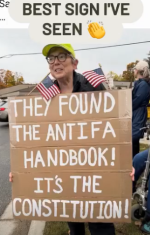There are so many government workers in Virginia who have been either fired or furloughed by trump!
You seem to be unaware of past events.
Under Harry Truman (1945–1953), post-World War II demobilization slashed executive branch civilian employment from over 3.8 million in 1945 to about 1.9 million by 1953—a net loss of roughly 1.9 million positions. This was driven by the end of wartime agencies and military-related civilian roles, not modern RIF procedures (which didn't exist until the 1940s Veterans' Preference Act). Exact involuntary separations aren't broken out separately from voluntary departures, but hundreds of thousands left involuntarily as entire offices closed.
Under Ronald Reagan (1981–1989), net civilian employment grew by about 240,000 despite early domestic cuts of around 66,000 in 1981–1982. Involuntary RIFs were minimal (fewer than 5,000 government-wide across his terms), as reductions focused on attrition and freezes. The 1981 air traffic controllers strike led to 11,000 firings, but those were for-cause terminations, not RIFs.
Under George H.W. Bush (1989–1993), post-Cold War drawdowns began, with net civilian employment dropping by about 100,000. Involuntary RIFs remained low (under 10,000 total), concentrated in Defense-related cuts tied to base closures.
Under Bill Clinton (1993–2001), the National Performance Review ("Reinventing Government") reduced executive branch civilian employment from 3.0 million in 1993 to 2.6 million by 2000—a net loss of over 400,000 positions (426,200 per OPM counts). This is the largest peacetime downsizing in history. Involuntary RIFs accounted for only about 6% of separations (roughly 25,000–30,000 government-wide). The vast majority left via $25,000 buyouts (over 112,000 accepted), early retirements, and attrition. Defense bore the brunt due to base closures, but cuts were gradual over seven years.
Under George W. Bush (2001–2009), civilian employment grew by around 100,000 net, driven by post-9/11 expansions at Homeland Security and Defense. Involuntary RIFs were negligible.
Under Barack Obama (2009–2017), net civilian employment fell by about 60,000–70,000, mostly due to 2011 Budget Control Act sequesters. Involuntary RIFs stayed very low (fewer than 10,000 total), with reductions via attrition and freezes. The 2013 shutdown furloughed 800,000 workers temporarily (16 days), but all received backpay.
Under Donald Trump (2017–2021), first term, net civilian employment dropped by around 50,000. Involuntary separations were minimal outside probationary firings (under 5,000). No mass RIFs occurred.
Under Joe Biden (2021–2025), civilian employment grew by about 138,000 net, with surges from Infrastructure Investment and Jobs Act and Inflation Reduction Act hiring. Involuntary RIFs were near zero.
That entire state is going to turn dark blue.
Think so?
Historical furloughs or reductions in force (RIFs) of federal employees have not caused Virginia voters to turn en masse against the responsible political party.
Several major episodes occurred before 2025:
- The 1995–1996 shutdowns (totaling 26 days across two periods) furloughed hundreds of thousands of workers nationwide, with significant impacts in Northern Virginia. President Bill Clinton's approval ratings rose afterward. However, this did not translate to an overwhelming shift in Virginia voting. In the 1997 gubernatorial election, Republican Jim Gilmore won comfortably with 56% of the vote against Democrat Don Beyer.
- The 2013 shutdown (16 days) under President Obama furloughed about 800,000 workers initially, yet it boosted Democrat Terry McAuliffe in the concurrent Virginia governor's race. McAuliffe defeated Republican Ken Cuccinelli by a narrow 2.5 percentage points (47.8% to 45.2%), with Libertarian Robert Sarvis taking 6.5%. Campaign aides from both sides later agreed the shutdown was decisive in costing Cuccinelli the election, but the result was close.
- The 2018–2019 shutdown (35 days) under President Trump furloughed 800,000 workers. It contributed to Democrat gains in the 2019 Virginia legislative elections, where Democrats flipped both chambers for full control. This was a clear backlash against Republicans, but not overwhelming. Republicans still held competitive seats, and the shifts built on existing trends rather than a total rout.


